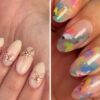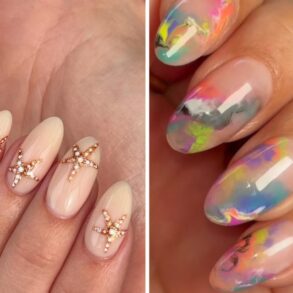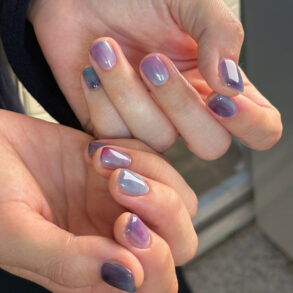Constanze Han’s photographs you inside nail shops all over the world, from Naples to Mexico City
In downtown Allman Town, a small community in Kingston, Jamaica, behind some government office buildings, you’ll find Terry’s Nail Shop. A wide range of customers, from all backgrounds, go to get their nails done at the shop, which operates out of Terry’s childhood home. “But even people who aren’t getting their nails done will go there to catch up on what’s going on in the community, get advice from Terry,” says photographer Constanze Han. “People will leave stuff there with her for other people to pick up. Some people have even had their kids wait there. Food and vegetable vendors know to stop there too. She has hired women from her community and trained them.” In the years Han has spent working in Kingston, Terry’s became one of her favourite spots. “If you think of the role a barbershop serves for some communities, that’s what Terry’s is. It’s a warm, safe space.”
But it’s not just Kingston – everywhere she goes, from Mexico City to Naples to London, Han has a network of nail artists that she looks forward to seeing, often spending whole days with them hanging out and catching up. “Nail artists can be your friend, your therapist. They are like a hairstylist, except you’re actually sitting face-to-face, hand-in-hand, sometimes for hours. So it feels intimate,” she says. The connection extends out from just the salon, as well – she’ll often catch the eye of women with interesting nails that she crosses paths with. A moment of communion between two strangers who find common ground. “It’s a nice feeling to be able to look at someone and be like ‘I see you’ and for them to be like ‘I see you too.’”
It’s all of these intimate bonds, along with the distinctive aesthetic of nail salons and the photogenic nature of nails, that contributed to Han’s decision to embark on a long-term project photographing nail culture around the world. From the intimate home-based nail shops in Havana to church ladies in Kingston, she captures the shared sense of charm, community and care that is found no matter where you are. Here we speak to Han about the series, spending time in nail salons and the creative artistry that goes into these manicures.
How did you start photographing nail shops?
Constanze Han: In Latin America and the Caribbean, where I mostly work, there are a lot of beauty industry workers, including nail techs and nail artists who are a part of the informal economy. In the fall of 2020, I started looking into how pandemic lockdowns, lack of government support and travel restrictions affected them and how they were recovering and surviving. While doing this work, I noticed that nail shops in Mexico City and Jamaica had such different and distinct looks from their signage to the way they displayed nails. This fascination is kind of how it all began.
Why was it something that you were interested in and thought there was potential as a long-term project?
Constanze Han: Nails are personal for me. Since the age of 16, I’ve always been so serious about getting my nails done. A few days before lockdown, I was in NYC and had gotten a new set of nails and hung on to that set for as many weeks as I could, probably five or six weeks. As they would start to pop off, I would glue them down, every day until they just wouldn’t stay on anymore, and I think that might be the first time in a decade that I didn’t have nails. I’ve gone through every phase of nails from stencil airbrush to all gold, red almond, and many intricate styles of nail art. Even when I look at old photos, different nails really bring me back to different chapters of my life.
When I started photographing nail shops and nail art, it was just so fun because of how photogenic nails are and whenever I would travel to places to work, I naturally expanded on this project. It became a long-term project when I realised the number of interesting people I was photographing and the amazing conversations that came with this felt limitless.
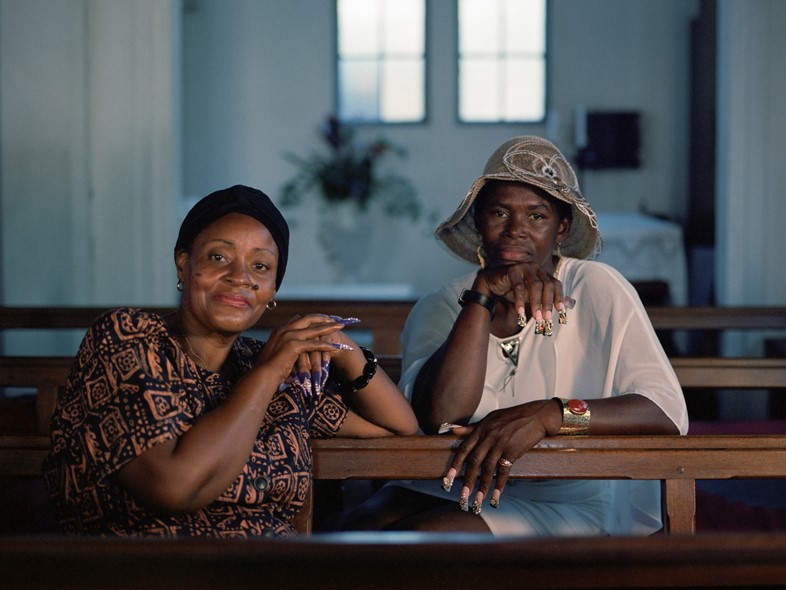
What have you discovered by spending time in these shops and nail communities?
Constanze Han: I’ve discovered that for many people, nails are far deeper than beauty. Nice nails really make people feel good. But even beyond that, it can be really unifying. I remember as a young person riding the train from Brooklyn to Manhattan and seeing other women who had interesting nails and making eye contact and sometimes having a little exchange or conversation. These interactions always felt so good. It still happens to me today, and I love this, because it’s often people who you might not regularly cross paths with. It’s a nice feeling to be able to look at someone and be like ‘I see you’ and for them to be like ‘I see you too’.
A more literal example is Maria Ortiz’s Long Nails Goddesses in Newark, New Jersey. Maria is a wonderful woman and amazing nail tech who has been specialising in super long nails for years, and somehow women who have really long nails have found her and will come from states away to see her. Some of these women have really moving stories about why they keep their nails long, or the discrimination they have faced, and through Maria, they have found community and fellowship with each other. Maria will cook and gather them together a few times a year at her shop – sometimes it is to celebrate important life events, other times it is to provide support for someone who needs it. It’s so human and so beautiful.
Do you have any stand-out memories from your time spent in nail salons?
Constanze Han: For me, what stands out is the conversation. I know this is a big thing that a lot of people can attest to. Nail artists can be your friend, your therapist. They are like a hairstylist, except you’re actually sitting face to face, hand in hand. Sometimes for hours, so it feels intimate.
There’s a few artists I look forward to seeing when I’m in their city. In Mexico City, I go to Roho. Before my appointment we will plan out the craziest intricate idea, like a hand-painted lion with my name in script and because we are friends, we will just spend the whole day together grabbing food and doing nails. In Napoli, I love going to Federica. Our friend Teresa, who is a producer she works with and I will go to her house and eat and hang out with her mom Loredana and sister Faby, who I’ve photographed. When I’m in London, I love going to Tasha or Imani and it’s like a girlfriend catch-up where we talk about feelings, dating, all that fun stuff. I just love the chat!
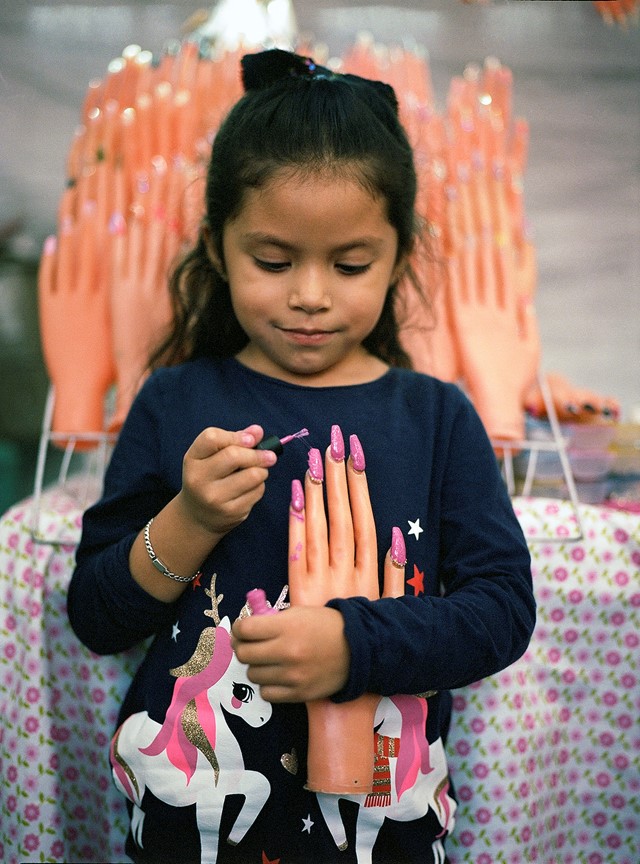
Do you think people underestimate the artistry that goes into nails?
Constanze Han: I think in the past people did underestimate it, but now that nail art has seen such a remarkable increase in popularity, it is starting to get the respect it deserves for artistry. However I think some nail artists would say that sometimes clients need a reminder that the time and labour means an added cost. With the advancements in nail technology, the boundaries that nail artists have pushed is incredible and there are things that artists are doing with nails that are undeniably art. If you see sculptural work like Soph, that’s actual miniature making! Or if you see how Krocaine hand paints, it’s undeniable that this is art on a tiny canvas.
In your work you look at the economic element of nails across communities around the world – can you talk more about that?
Constanze Han: For sure. Dating back to the late 1800s with the opening of nail salons to the 1970s when actress Tippi Hedren and her nail tech trained Vietnamese refugee women how to do nails, nails have always had an important economic element, especially for women. Today, in most parts of the world, for women who have traditionally had some proximity to beauty, working as a manicurist is an accessible career path with a reasonably low barrier to entry. Many can choose to set up shop in their homes, something that can accommodate a low overhead and motherhood. And of course, for those who are interested in artistry that is something they can expand on.
The reality is that a lot of mothers and daughters, sisters, friends have been painting each other’s nails for decades so there is something very familiar and comforting in this act that makes it feel ‘doable’ when scaling it into a business.
How do you hope these images will make people feel?
Constanze Han: A lot of the images were made in people’s homes and intimate spaces and I felt very welcomed and embraced while making them and hope that is conveyed. I hope these photographs feel inviting. The really nice thing about this is that this is a community that almost anyone can take part in across age, race, nationality, religion, gender identity. I hope that viewers can find a little joy in the work and also see themselves in it.
This post was originally published on this site be sure to check out more of their content.


